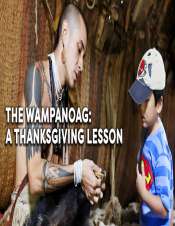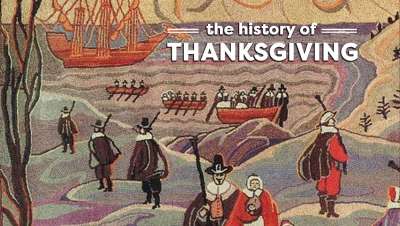
Objectives
- Students will understand the Wampanoag people.
- Students will consider the background of Thanksgiving and what the holiday means to them today.
Materials
- Wampanoag Thanksgiving Worksheet
- http://www.plimoth.org/learn/just-kids/homework-help/who-are-wampanoag
Procedures
- Ask for volunteers to tell the story of the Pilgrims and Thanksgiving. Write the basic details on the board. These might include arrival on the Mayflower, help from friendly Indians, and a harvest meal including corn and turkey.
- Ask the students: “From whose point of view do we usually hear the Thanksgiving story?” We may know that the Pilgrims were leaving religious persecution in Europe and that they were trying to make a new home in America; but what do we know about the Indians whose home it already was?
Background Information:
The Indians in the classic Thanksgiving story are the Wampanoags, a tribe that has lived for thousands of years in what is today coastal Massachusetts and Rhode Island. The Wampanoags experienced difficult times during the beginning of the 1600s when they were attacked by a warring tribe to the north; they were also devastated by a series of epidemics that killed many of their people all but one of the Patuxet Wompanoag tribe. Then, in 1620, a ship carrying European settlers landed off the coast of Massachusetts. The people, who would eventually be called Pilgrims, started a settlement at an abandoned Patuxet Wampanoag village. Some native people helped them through their first difficult year (nearly half of the Pilgrims starved to death) teaching them how to grow and gather native food. The two groups signed a treaty of friendship that probably meant very different things to each of them. Because the Wampanoags, like most Native Americans, had no concept of owning land, it was most likely just a sign of goodwill. In European culture, however, a treaty meant the land now belonged to them. The Wampanoags also probably found no harm in signing such a pact with a group of people who seemed so harmless and inept; after all, the white settlers were struggling just to stay alive. When the Pilgrims harvested their first crop, about a year after their arrival, they shared some food with Wampanoags who happened to be visiting. This was the first Thanksgiving.- After you've shared the Wampanoag's story with the students, direct them to Plimoth Plantation's website about the tribe. Working in pairs, have them complete the Wampanoag Thanksgiving Worksheet.
- Ask the students: “From whose point of view do we usually hear the Thanksgiving story?” We may know that the Pilgrims were leaving religious persecution in Europe and that they were trying to make a new home in America; but what do we know about the Indians whose home it already was?
Assessment
Use the Wampanoag Thanksgiving Answer Key to check students’ work.
Extension Activities
- Use the lessons and resources in TeacherVision's Thanksgiving Theme.
- Research and study other harvest festivals around the world.
- Draw pictures of favorite Thanksgiving memories.
- Visit the Plimouth Plantation's interactive website to learn more about the Wampanoag and the first Thanksgiving:
http://www.plimoth.org/media/olc/wampanoag.html
FutureFit Extension Activities
Relate: Giving Thanks Around the World
In this activity, students will learn about thanksgiving and harvest holidays around the world.
Students will discuss how the Wampanoag Thanksgiving compares/contrasts with their own holiday traditions. Then, lead a discussion on other thanksgiving holidays from other cultures. This slideshow from the Travel Channel is a good jumping-off point, or students from other cultures can share their traditions with the class.
Organize a potluck Thanksgiving feast, bringing in items that are a part of their Thanksgiving or holiday traditions from other cultures.
Investigate: Thanksgiving Through the Years
After completing the lesson on the Wampanoag Thanksgiving, students will research how Thanksgiving has changed from the first celebration to the present day.
Break students into groups and have each group research a particular place in time. For instance, one group will research the first Thanksgiving. Another will research Thanksgiving practices up until it was declared a holiday in the 19th century. Another group will research evolving Thanksgiving traditions from the 19th to the 20th century, etc. Students will then present their eras to the rest of the class.
Depending on student ability and grade level, presentations can be completed in groups or individually.




